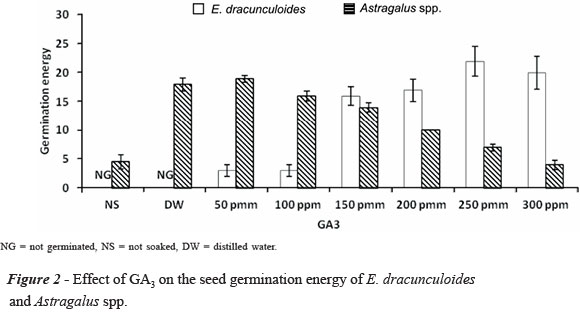The aim of this study was to examine the dormancy behavior of Euphorbia dracunculoides and Astragalus spp., weeds of arid chickpea. The dormancy breaking treatments were: Gibberalic acid (GA3) and Thiourea each at 50, 100, 150, 200, 250, and 300 ppm and Potassium nitrate (KNO3) at 5,000, 10,000, 15,000, 20,000, 25,000, and 30,000 ppm (24 h soaking). Germination (G) percentage and germination energy (GE) of E. dracunculoides was maximum (89 and 22, respectively) at 250 ppm concentration of GA3 and 81.50 and 11.50 at 15000 ppm concentration of KNO3. Thiourea at 250 and 300 ppm resulted in maximum G percentage (51) and GE (25.50) of E. dracunculoides, whereas the G percentage and GE of Astragalus spp. were maximum (28 and 19, respectively) at the lowest concentration of GA3 (50 ppm). On the other hand, 5000 ppm and 150 ppm concentration of KNO3 and Thiourea showed maximum GE (19.5) and G percentage (28) of Astragalus spp., respectively. Overall, effective dormancy breaking chemical against E. dracunculoides was GA3 (250 ppm) while in Astragalus spp. none of chemicals showed very impressive results. These results showed that both weeds' seeds have dormancy in their habit. Hot water treatment and the above mentioned chemicals (best concentrations) when used with 4, 8, and 12 hours soaking showed ineffective results.
GA3; KNO3; thiourea; dormancy; E. dracunculoides; Astragalus spp







